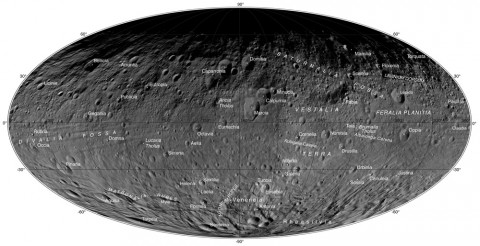 Pasadena, CA – An atlas of the giant asteroid Vesta, created from images taken as NASA’s Dawn mission flew around the object (also known as a protoplanet), is now accessible for the public to explore online. The set of maps was created from mosaics of 10,000 images taken by Dawn’s framing camera instrument at a low altitude of about 130 miles (210 kilometers).
Pasadena, CA – An atlas of the giant asteroid Vesta, created from images taken as NASA’s Dawn mission flew around the object (also known as a protoplanet), is now accessible for the public to explore online. The set of maps was created from mosaics of 10,000 images taken by Dawn’s framing camera instrument at a low altitude of about 130 miles (210 kilometers).
The maps are mostly at a scale about that of regional road-touring maps, where every inch of map is equivalent to a little more than 3 miles of asteroid (1 centimeter equals 2 kilometers).

“The atlas shows how extreme the terrain is on a body the size of Vesta. In the south pole projection alone, the Severina crater contours reach a depth of 11 miles [18 kilometers]; just over 60 miles [100 kilometres] away from the mountain peak towers about 4 miles [7 kilometers] high.”
Read the full news release from the European Planetary Science Congress.
View the images online .
The Dawn mission to Vesta and Ceres is managed by NASA’s Jet Propulsion Laboratory, a division of the California Institute of Technology in Pasadena, for NASA’s Science Mission Directorate, Washington. The University of California, Los Angeles, is responsible for overall Dawn mission science.
The Dawn framing cameras were developed and built under the leadership of the Max Planck Institute for Solar System Research, Katlenburg-Lindau, Germany, with significant contributions by DLR German Aerospace Center, Institute of Planetary Research, Berlin, and in coordination with the Institute of Computer and Communication Network Engineering, Braunschweig. The framing camera project is funded by the Max Planck Society, DLR and NASA.
Written by Whitney Clavin
NASA’s Jet Propulsion Laboratory, Pasadena, CA


